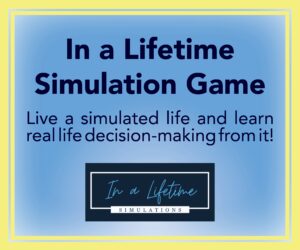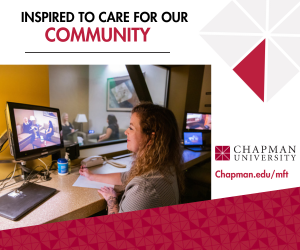This past spring, we had the pleasure of presenting together at the 2024 AAMFT Leadership Symposium in Phoenix. The title of our presentation was “Expanding the Frame: Leading the Charge on Relational, Multigenerational, and Systemic Awareness Among Mental Health Professionals.” We are both program directors of small, relatively nascent MFT programs in the Bronx, located roughly six miles apart.
The two of us have had similar experiences advocating for our students in the field when it comes time to place them at practicum or internship sites. Notably, many sites in the greater NYC area are more amenable to social workers and mental health counselors, while marriage and family therapy trainees are often left out of the mix entirely. This led us to conceive of the “family” of mental health providers in New York state in such a way as to expand the awareness of our valuable skills and thus create opportunities for MFT students in the marketplace. We utilized an ecosystemic lens to further examine the multiple contexts in which MFTs exist and as a catalyst for exploring interventions that may support the growth of the MFT profession in New York state.
The state of MFT in New York State
At its essence, the state of MFT in New York state can be summed up in three words: room for growth. Even though both the Mental Health Counseling and Marriage and Family Therapy licenses have existed in NY state for over two decades now, our numbers pale in comparison to social workers. According to the New York State Education Department’s (NYSED) Office of Professions, for the calendar year 2023, 177 new LMFTs achieved licensure in NY state compared to 1,209 Licensed Mental Health Counselors (LMHCs) and 2,095 Licensed Clinical Social Workers (LCSW) for the same year. The Office of Professions also reports that as of January 1, 2024, 1,297 LMFTs, 10,081 LMHCs, and 28,415 LCSWs were registered in New York state. Yes, you read that correctly – there are roughly 22 times more licensed clinical social workers in NY state than there are licensed marriage and family therapists. By comparison, according to California’s Board of Behavioral Sciences (BBS), as of July 17, 2023, there were 53,362 LMFTs and 37,235 LCSWs registered in California. The overall population of California is roughly twice that of New York state, however the ratio of the professions denotes the stature of the MFT profession in the field. Given such numbers, one can see there is certainly room for growth for the MFT profession in the great state of New York.
 As any clinician or academic administrator can attest, growth is not easily achieved. Often, there is discomfort and concomitant growing pains with any expansive enterprise, and MFT in New York is no different. The low numbers of LMFTs in NY state are indicative of some structural and systemic issues that are contributing to the inequities. NYSED’s data regarding the number of licensure qualifying mental health counseling, social work, and marriage and family therapy programs in NY state, tell the story.
As any clinician or academic administrator can attest, growth is not easily achieved. Often, there is discomfort and concomitant growing pains with any expansive enterprise, and MFT in New York is no different. The low numbers of LMFTs in NY state are indicative of some structural and systemic issues that are contributing to the inequities. NYSED’s data regarding the number of licensure qualifying mental health counseling, social work, and marriage and family therapy programs in NY state, tell the story.

There are eight MFT training programs in NY state (three are COAMFTE accredited). By comparison, there are 44 licensure-qualifying MHC training programs and 24 social work training programs in New York. Additionally, there are no MFT training programs within the CUNY (City University of New York) or SUNY (State University of New York) systems; all eight MFT programs are housed in private institutions. This is problematic from a diversity, equity, and inclusion perspective as CUNY and SUNY graduate tuition costs are a fraction of the cost of private school tuition. Students from underprivileged socioeconomic backgrounds who might otherwise be excited by the prospect of a career in marriage and family therapy could immediately be turned off by the cost of admission, and therefore turn to a more economical social work or mental health counseling degree.
A systemic lens
MFTs in NY state exist within a broader context of mental health providers. By conceptualizing the context of mental health providers as a multigenerational “family,” we can better understand the aforementioned inequities and suggest a systemic lens for understanding how MFTs have come to be so underrepresented in NY state. We’ve conceptualized the family of mental health providers to include grandparents (psychiatrists), parents (social workers, psychologists), and siblings (mental health counselors as competitive older siblings; marriage and family therapists as the youngest sibling, or the “baby” of the family). We are calling this conceptualization the metasystemic level, thereby expanding Bronfenbrenner’s Ecosystemic Lens.
Bronfenbenner identified microsystemic, mesosystemic, exosystemic, macrosystemic, and chronosystemic levels that impact an individual. We are utilizing this model to identify issues that potentially impede the growth of the MFT profession within NY state and quite possibly other states as well, as we observed at the 2024 Leadership Symposium. Through our metasystemic lens, with MFTs conceptualized as the youngest sibling in the family of mental health providers in NY state, we can also think of MFTs as the Identified Client (IC) — the one who is tasked with bringing the entire system to the table to engage, communicate, and coordinate more effectively.

Apart from being outnumbered in the number of licensees and training programs in NY state, marriage and family therapists stand out from other providers due to the scope of their work. MFTs are not solely symptoms-focused, but rather systems-focused. This focus on systems includes biopsychosocial, psychospiritual, and multicultural lenses, which aim to view the whole person within their whole context. These characteristics set MFTs apart from others in the field and often make their work more difficult to fit into the existing community mental health paradigms that were constructed under the medical model. This speaks to the microsystemic level which looks at the environment that immediately surrounds the IC.
The microsystems of MFTs include the places we practice: community based organizations, community mental health clinics, hospitals, and training programs—master’s and doctoral level. The mesosystemic level looks at the interactions between these microsystems. Often, the policies of these microsystems do not align in a way that facilitates collaboration. For example, as mentioned above, there are facilities whose policies dictate that they can only accept social work trainees for practicum or internship positions. This creates barriers for students in MFT training programs to get the supervised hours they need to complete their master’s programs.
 The exosystemic level looks at the larger social and environmental contexts that have an indirect impact on the IC. Part of this context are third-party-payers who do not reimburse for family therapy, existing psychoanalytic and cognitive-behavioral biases that inform funding for research, as well as under informed government policies that determine licensing for professions in NY state. Historically, neither MFTs nor MHCs have been eligible to diagnose in NY state. This has kept us beholden to social workers, psychologists and psychiatrists (parents and grandparents) as they have always been able to diagnose. This has impeded the ability of MFTs to take on supervisory roles and advance professionally within some facilities. Thankfully, with the momentum of years of legislative advocacy, as of June 2024, LMFTs are eligible to apply for a license in NY state with diagnostic privileges.
The exosystemic level looks at the larger social and environmental contexts that have an indirect impact on the IC. Part of this context are third-party-payers who do not reimburse for family therapy, existing psychoanalytic and cognitive-behavioral biases that inform funding for research, as well as under informed government policies that determine licensing for professions in NY state. Historically, neither MFTs nor MHCs have been eligible to diagnose in NY state. This has kept us beholden to social workers, psychologists and psychiatrists (parents and grandparents) as they have always been able to diagnose. This has impeded the ability of MFTs to take on supervisory roles and advance professionally within some facilities. Thankfully, with the momentum of years of legislative advocacy, as of June 2024, LMFTs are eligible to apply for a license in NY state with diagnostic privileges.
Sometimes, as within a family system, it can be difficult for roles to shift and for older generations to see younger generations as equals or as bringing value to the conversation.

When looking at the sociocultural factors (macrosystemic level) that have influenced the development of the MFT profession in NY state (the IC), we see the influences of competition between the various professions rather than a sense of collaboration. This competition is born out of a variety of factors, including a scarcity mindset and hierarchy within the field of mental health. This hierarchy, established under the lens and culture of the medical model with the treatment of “patients” can prevent facilities from hiring MFTs under the impression that they aren’t as skilled or as capable as social workers or mental health counselors. Sometimes, as within a family system, it can be difficult for roles to shift and for older generations to see younger generations as equals or as bringing value to the conversation. The IC (youngest sibling) can have a tough time being heard by the “grandparents” and “parents” as they work to get a seat at the table.
It is taking time, but MFTs are becoming more visible (chronosystemic). The current dialogues within the mental health field and within broader layman’s conversations are taking on a systemic lens. Our society is becoming more aware of and valuing the importance of identity, culture, systemic oppression, and other factors that are taken into consideration when utilizing a systemic lens. The textbooks used to teach therapeutic microskills and lifespan development across the professions are utilizing an ecosystemic lens to explore the multiple factors that impact development and relationships over time. Training programs are slowly becoming more oriented to the interpersonal as well as the intrapsychic—eschewing binary, either/or thinking for more inclusive both/and approaches.
Where do we go from here?
Expanding the frame and applying the metasystemic lens to the issue of the status of MFTs in New York state, interventions can be more clearly identified:
- Advocate to establish MFT programs within the SUNY and CUNY educational systems.
- Recognize that this is a social justice issue, and address the accessibility and affordability of MFT training programs for all students.
- Develop undergraduate professional “pipelines” in anthropology and sociology in addition to psychology that lend themselves naturally to MFT graduate study.
- Build MFT tracks within other existing master’s licensure training programs. This approach facilitates the growth of MFT without overburdening programs to immediately increase their costs.
- Encourage more cooperation, coordination, and communication among LMFTs and MFT training programs in New York state.
- Promote a systemic approach to treatment that values family awareness, identity, and other sociocultural considerations.
- Work on multidisciplinary teams, communicating with our respected colleagues in other fields and sharing our ideas about how a systemic lens can help our clients. Systems-thinking is our superpower—it brings unique insight to a case; our expertise is valuable.
In the aftermath of the Covid pandemic, there are plenty of people who need the support of mental health providers—there is no scarcity in clientele. Mental health providers must work together and model cooperation and collaboration, not competition. MFTs, as the least-developed mental health profession in New York state (and in many other states), are uniquely positioned for growth. We can apply our metasystemic awareness to expand the very academic and professional systems we engage with and are part of. As MFTs we must embrace and expand the frame of our systemic lens to form our collective voice and advocate for ourselves just as we encourage our family clients to do for themselves.

Michelle A. Bell, PsyD, (she/her/ella) is an AAMFT Professional member, a bilingual/bicultural, licensed psychologist in NY state, and a systems therapist specializing in working with children and families for over 20 years. Dr. Bell is the owner of Inwood Family Guidance and the Program Director of the Manhattan College MFT program in NYC. Dr. Bell also dedicates time advocating for the rights of Children in Migration through her work as a Representative of the APA to the United Nations and as a member of the NGO Committee on Migration.

Sharon Marianetti-Leeper, PhD, LMFT, LCAT, is an AAMFT Professional member holding the Clinical Fellow and Approved Supervisor designations, an LMFT in NY state, as well as a licensed creative arts therapist (LCAT). She is the Program Director of the MFT program at Ferkauf Graduate School of Psychology (Yeshiva University) in NYC. She also runs her own private practice where she employs expression and creativity in her work with individuals, couples and families. She has over 20 years of experience in the fields of education and mental health.
Other articles
An Invitation to Explore Ecotherapy
In the early months of the COVID-19 pandemic, with fear and the unknown weighing heavily, I wrote an article about taking therapy outdoors as “A Natural Approach to Current Mental Health Challenges” (Family Therapy magazine, July/August 2020). Therapy, which pre-pandemic was almost exclusively provided face to face in offices around the world, was catapulted onto the online platform and clients found themselves seeing their therapists in closets, bathrooms, bedrooms, cars; anywhere they could find some privacy and an internet connection.
Lauren Kahn, MSW
Laugh Rather Than Lecture: A Humorous Approach to Excessive Mobile Phone and Social Media Use
In the world of modern technology, the rise of Internet gaming disorder (IGD), excessive social media use, and excessive mobile phone use has become a real head-scratcher for families everywhere. As a marriage and family therapist with a knack for humor and a background in researching IGD, MMORPG, and suicide, I’ve had my fair share of laughable moments in the therapy room.
Ezra Lockhart, PhD
Helping Clients Understand the Differences: The Importance of Psychotherapy in an Unregulated Coaching Landscape
In the modern age, there is indeed a focus on mental wellness. Individuals seek guidance and support to navigate the complexities of their lives. Amidst the myriad options available, from psychotherapy to coaching, it’s imperative to discern the nuances between these practices, particularly concerning regulatory oversight and the protection of clients’ well-being.
Ezra Lockhart, PhD



